|
|
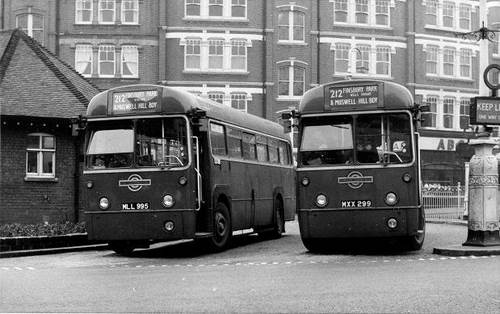 Red RF routes Red RF routes
Route 212
Page last updated 1 January
2017
A significant route for us because our RF486 was delivered new to Muswell Hill garage in
February 1953 for the 212. A high capacity route that used
single deckers until the weak bridge on Muswell Hill was rebuilt
and was London's highest-frequency RF route.
RFs 358 and 411 lay
over at Muswell Hill Broadway. Of interest is the subtle
difference between the blinds - RF358 shows 'Finsbury Park
Station', whilst RF411 has 'Finsbury Park Wells
Terrace'. See our Finsbury
Park page for more - these are the same terminus. Neither
bus spent long at MH, so the photograph can be dated to late
1959. Photo
© Fred Ivey
Dates of RF operation
4 Feb 53 to 5 Jan 60
(total 6 years 11 months, all crew operation)
Express service Mon-Fri peaks introduced 12 Oct 55
Destinations
FINSBURY PARK Wells Terrace and MUSWELL HILL
BROADWAY
Reason for single-deck operation
Unlike the effect of most rail bridges in this respect, it was
a weight restriction on the bridge over the railway on Muswell Hill that
caused the route to be operated by single-deckers until 1960,
despite being one of the busiest routes in London and losing London
Transport substantial sums.
 A B-type on route 111 climbing Muswell Hill, passing
Muswell Hill Station (and its coal yard) and about to cross
the offending bridge. B2706 was one of 30 'bentwood'
single-decker Bs built in 1914 and soon commandeered by the War
Office. Only three returned; this was not among them.
Compare this design with the more 'traditional' body on the B-types
used on the 109. Photograph John Hinson collection
Route history
Originally numbered the 111, the route was introduced by
the General in April 1914 from Finsbury
Park to Muswell Hill. Due to a weight restriction over
the railway bridge on Muswell Hill, the route was operated by
single-deckers until 1960, despite becoming one of the busiest
routes in London. Providing a link to Finsbury Park Station
for the tube-less residents of Muswell Hill and Crouch End, the
route operated every 2 ½ minutes in 1924; this improved
to every 2 minutes in 1931 with the introduction of faster Scooters
and a reduction in the journey time from 19 to 16
minutes.
When the route was introduced, fixed bus stops were unknown in
London; buses stopped wherever required. The concept of the
bus queue was therefore also not established. But in 1913,
the General started to experiment with bus queues in certain
locations, and quickly found that 'they had an enormous effect in
reducing congestion'. Six years later, a report listed the 49
points across London included in the experiment. It is a
testament to the volume of traffic already carried by the 111 that
no fewer than 4 of the 49 were at points used solely by the 111
(Muswell Hill Broadway, foot of Muswell Hill, Crouch End
Clock Tower and Finsbury Park Station).
Initially worked by Holloway garage (J) using B-types [see
foot of page], the 111 was one of the routes on which the new 26
seat type-7 Bs were introduced in 1921, only for the General to
discover that the new buses were too heavy and have to resuscitate
20-seat pre-war buses. Indeed, in the same year,
the LGOC and two drivers were fined at Highgate Police Court
for running double deckers on the route over the weight restricted
railway bridges at Crouch Hill and Muswell Hill (could The Times
have their facts slightly wrong and be referring to the new Bs, by
any chance?).
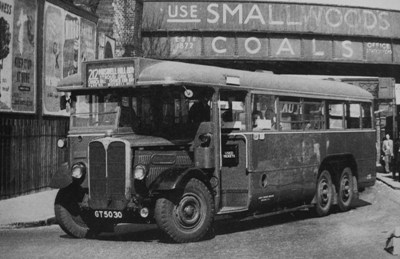 The coal-siding bridge over Wells Terrace,
Finsbury Park, in full view above Muswell
Hill's LT1164, rebuilt in 1949 by Marshalls of Cambridge, turning
into Clifton Terrace. The bus retains its petrol engine, and
is on temporary loan to MH (the bus was not allocated there after
rebuild).
The 111 was reallocated to Muswell Hill (MH) when that garage
opened on 23 Sep 25 and the Bs were replaced by new K-types in
1925-27, still only with 20 seats and with solid tyres, unlike some
of the single-deck Ks built at the time which had 22 or 24
seats and pneumatic tyres. The Metropolitan Police required
the use of sprag gear as a safety measure on steep hills, and this
was incompatible with pneumatic tyres (this problem was solved on
later models by the introduction of four-wheel braking in 1926,
pioneered by Dennis and the London independent Admiral, not by
LGOC).
In March 1931, the prototype LT Scooter was moved from Edgware
to Muswell Hill to be tried on the famously steep hill (up to 1 in
9, the steepest long hill that Scooters would operate on), followed
in April by another 25, replacing all of the Ks by the end of
that month. At 35 seats, these provided a substantial boost
to the capacity of the route. With seven fewer buses
required for the 111 on Sundays, MH provided these seven to assist
J with the extra traffic on the 110 (later 210).
With most routes now operated by pneumatic-tyred buses, for
which the speed limit was 20mph rather than 12mph, a programme of
speeding up routes using the same frequencies resulted in more
efficient use of buses. This was applied to a number of
routes in November 1932, including the 111, from which three LTLs
were released to help convert the 105 (later 201) to LTL operation.
The route was renumbered on 3 Oct 34
into the new 200-series of single-deck routes. Full blinds
were provided for the 212, with the more familiar 'lazy' blinds
only appearing around 1948; blinds for the garage journeys from
Finsbury Park, run in service, stated 'Colney Hatch Lane
Hampden Road via Colney Hatch Lane', ignoring all the
points passed on the main route (this was improved on the post-war
blinds, when the display became 'Muswell Hill Hampden Road
via Colney Hatch Lane'). Being such a short route, conductors
carried a special short ticket rack with only about three packs of
tickets on each side.
Officially, the LTL allocation lasted until April 1947.
In 1946, there was a phased replacement by new 14T12
Regals. The 7.7 litre AEC diesel engines of the Ts proved
underpowered ascending Muswell Hill, so from December 1946 they
(and two of the Scooters on the 210) were
in turn replaced by the whole of the first batch of 31 TDs,
with 7.4 litre Leyland engines and Weymann bodywork, a process
completed in June 1947.
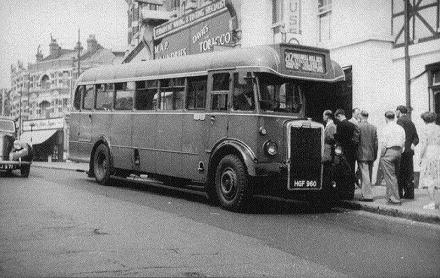 TD2 about to pick up in Muswell Hill Broadway once the
driver resets the blind for its journey to Finsbury Park; the older
full blind display is carried. Note the flared rear lower
panels of the Weymann-bodied TD, classic Weymann and unlike the
later Mann Egerton bodies. Photo Ian Armstrong collection
Next the 251, then worked from MH
with Scooters, converted to TD using nine of the second, Mann
Egerton-bodied, batch of TDs in spring 1949. The balance
of the 210 and Muswell Hill's other single-deck route 244 retained Scooters right through to
1952. Some shared workings between the 212
and 244 meant that one official LT working reappeared on the
212, Mondays to Fridays, from November 1947 to December
1949. Unofficially, Scooters worked regularly on the 212, as
MH inevitably mixed the nominally-separate allocations. During their official allocation on the route, the Scooters
still retained their petrol engines. Conversion of the
majority of the class to diesel, using engines from scrapped STLs
commenced in 1949 with buses allocated to Elmers End for the
227 and Croydon for the 234 group. However, when the first diesel
Scooters arrived at MH, they were found to be unable to climb
Muswell Hill without the use of first gear for much of the
climb. Chiswick engineers conducted tests in 1950 and found
that the fuel pumps required adjustment, resulting in changed
settings being adopted across the fleet (David Ruddom recalls that
the crash gearboxes required considerable expertise to change down
into first gear if a full stop was to be avoided).
A postscript to this episode came in 1952. With the
Scooters still unpopular, the union suggested that withdrawn Green
Line 6Q6s, replaced on the 715 by new RFs, be used to
replace them and this was accepted (even though their hill-climbing
ability was unlikely to be better). The last 18 Scooters at
MH were delicensed overnight on 18 Mar 52 and the Qs replaced them
on the 210 and 244, still in Green Line livery. Although none
are known to have worked the 212, this may have happened. The
Qs were a stopgap - LT delivered on their promise that MH
would receive the first red RFs (for the 210, in September 1952)
and the Qs were withdrawn - leaving the TDs to work alongside the
RFs.
Has anyone ever seen a
photo of an RF on the 212
Express? Fortunately, John Herting was on hand, some
years after conversion to RT, to capture RT1177 in Park Road (at
the Farrar Road junction) one evening in 1968 or 1969.
Photo
© John Herting
The two-minute frequency on the 212 lasted into the
1950s. LT would have dearly loved to run double-deckers
- by 1950, the route was losing £20,000 p.a. due to the higher
staff cost per passenger of
single-deckers. Following inconclusive correspondence
with the railway company about strengthening the bridge on Muswell
Hill, in 1954 (the year passenger service on the
line ceased) this moved on to correspondence about possible
closure of the line 'if the coal
traffic could be redirected'. In the end, it took until
early 1960 before the bridge was rebuilt and the route could be
double-decked.
The peak requirement of the 212 increased steadily over the
years, to a maximum of 23 LTLs in 1943, then 27 in 1946 when run by
a mixture of LTLs and Ts and finally 30 TDs in 1952, falling
back slightly to 29 after the introduction of the larger RFs -
but twenty-nine 41-seat RFs provided 20% more seats
than thirty 33-seat TDs.
The 212 was the second route at Muswell Hill garage
operated by the RF class, from February 1953. The first two
of the second batch of RFs were licensed on Wednesday 4
February and it is presumed that they entered service on the 212
(rather than the 210) on that day (there appear to be no records to
confirm this). The last few were held back and not licensed
until 1 March. The route required many more buses than the
210, but was busiest Monday to Friday, whereas the 210 was busier
at weekends, particularly Sundays. Hence the 31 new buses
allocated for the 29-bus peak requirement on the 212 also provided
just enough (at least in theory) for the 210 to convert fully to RF
at the weekends. In addition, there were enough buses to
allocate some RFs to the 251 on Saturday
and, when the winter schedules came in and the 210 requirement
reduced, on Sunday as well. Meanwhile at Muswell Hill, the
244 kept its TD allocation. It
seems likely that the reality continued to be less clear-cut
than this.
The route was still under pressure, despite the increase in
capacity provided by the RFs, so to ease the plight of passengers
at intermediate stops waiting in vain for a bus with room to
board, a Monday to Friday peak-hour Express service was added from 12 Oct
55. This ran the full length of the route in both directions,
stopping only at Alexandra Park (Muswell Hill Victoria
Hotel) and Crouch End Broadway, but as the faretable shows, the morning peak journey
to Finsbury Park was the key section. Blue blinds with white
lettering were apparently used, but these journeys seem to
have eluded the photographers - does anyone know of a picture
of an RF-operated 212 Express? The Express was
highly successful and continued right through the RT era until
replaced by MBSs on the W2 in 1968.
A reader has kindly drawn our attention to a film on the
internet including (amongst a tribute to north London floral public
spaces and period street scenes) rare colour footage of RFs on the
212, briefly at about 02:45 of the
film here (note
- the first few seconds are blank). A screen grab is here.
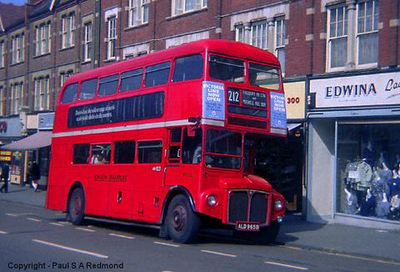 Extra capacity. The later Routemasters (with
offside illuminated advertisements) were delivered to Muswell Hill
for the 134, but after a 1967 repaint, RM1965 is seen here,
otherwise in original condition, after the use of an ultimate blind
on the short 212 was abandoned. Stuart Perry comments
that RM1965, a long term resident at MH, was a good
bus but not quite as good as his favourite RM1640 (which is still
at work on the Heritage service). Photo
© Paul Redmond
The route finally converted to RTs in January
1960, once the bridge on Muswell Hill over the abandoned
railway had finally been dealt with. 21 RFs moved
overnight to Kingston to convert the 218/ 9. One of the additional burdens on the 212 was the Alexandra
Park Racecourse, active until 1970. Just like Kenwood and the 210, this was a big
attraction which would have seen exceptional RF loadings for the
evening race meetings. Stuart
Perry notes that by the mid 60s, all the routes serving
the course (212, 233, 217 and 231) were
double-deck RT operated, but earlier the first two routes would
have been using the RF. 'The punters had the choice of
leaving the Piccadilly Line at either Finsbury Park, Turnpike Lane
or Wood Green, but from central London obviously Finsbury Park came
first and I know we struggled to shift the crowds with the RT so it
must have been even more hectic with the RF. On race nights
there was an absolute priority that all the 212 duties were covered
but no extras as far as I recall. But Wood Green
Station crowds then used the 233, meaning of course that the
233 crews from WG and later WN had to cope with a double whammy as
the punters could reach the course from both directions of travel
on the 233. Having said that Finsbury Park remained the favourite
option for most.'
RTs remained on Monday to Friday up to the end of the route,
but operation switched to RMs at weekends in June 1963.
Stuart comments that the RMs carried blue Express lazy blinds, even
though the Express did not operate at weekends, so it is doubtful
that they were ever used. The route converted to one-man
flat-fare operation in the changes of May 1969, being renumbered W7
in the Wood Green series. The last 212 was an RT on 9 May 69.
The W7 continues over the same route today. Still
very busy, it is the only suburban double-deck route to have been
pay-before-you-board, having hosted the 2001 trial of the
roadside machine system before its introduction in central
London.
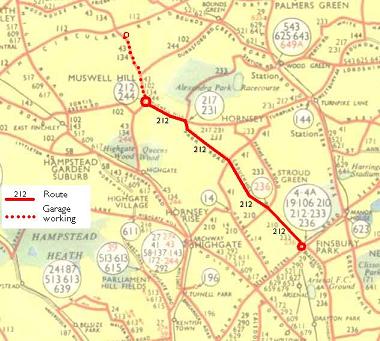 RF route
in detail, with timing points RF route
in detail, with timing pointsFINSBURY PARK Wells Terrace, Clifton Terrace, Lennox
Road (return direct from Stroud Green Road to Wells Terrace),
Stroud Green Road, Stroud Green
The Stapleton, Crouch Hill, Crouch End Broadway, Park Road,
Muswell Hill Victoria
Hotel, Muswell Hill, MUSWELL HILL BROADWAY
Garage journeys: to/from Muswell Hill Broadway via Colney
Hatch Lane
Based on 1955 bus map ©
London Transport
Faretable
We don't have access to the faretable during RF
operation. However, to view the faretable (including garage
journeys) for May 1965, when the route was RT operated, click
here; for the Express working, click
here. Note that higher fares for
short journeys were only charged before 0945 and only towards
Finsbury Park, moving the crowds to Finsbury Park being the key
role for the 212.
Frequency
| Year |
Mon-Fri |
Sat |
Sun |
| 1936 |
2 mins |
2 mins |
2½ mins |
| 1941 |
3-4 mins |
3-4 mins |
4-6 mins |
| 1946 |
1½ mins* |
1½ mins*
|
4-6 mins |
| 1951 |
2-5 mins |
2-5 mins |
2-5 mins |
| 1953 |
1-3 mins |
1-3 mins |
2-6 mins |
| 1959 |
2-4 mins† |
2-4 mins |
2-6 mins |
* Including short workings between Finsbury Park and Crouch
End
† Plus 212 Express every 5 minutes (peaks)
From Finsbury Park, the route took about 8 minutes to
reach Crouch End and 16 minutes to reach Muswell Hill
Broadway. The 1959 timetable (including the Express) is
here.
RF allocation
New RFs delivered Feb 53: 436, 443, 449-453, 462, 466-467,
469-473, 475-478, 480-487 (total 27 + 4 second hand = 29 +
2 spare)
PVR 1953 (Feb): Mon-Fri 30, Sat 23, Sun 20
PVR 1953 (May): Mon-Fri 29, Sat 23, Sun 20
PVR 1953 (Oct): Mon-Fri 26, Sat 19, Sun 18
PVR 1954 (Mar): Mon-Fri 24, Sat 19, Sun 16
PVR 1955 (May): Mon-Fri 23, Sat 18, Sun 16
PVR 1955 (Oct): Mon-Fri 23, Sat 18, Sun 15
PVR 1958 (Nov): Mon-Fri 21, Sat 15, Sun 15
Looking at these allocations, it is worth
remembering that the route only took 16 minutes from end to
end.
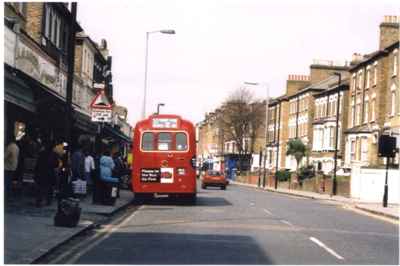 Memories MemoriesDave Wangford lived
on Crouch Hill for about 18 months in 1954. One of his
abiding memories is the frequency of the service on the 212:
'I was about 11 years old and used the 212 service to get to
school in Finsbury Park at Blackstock Road School, which was a
short walk from the terminus in Wells Terrace. I can recall
coming out the front door and seeing a bus heading towards
Finsbury Park coming down the hill, but not worrying about not
getting to the bus stop (about 100 yards away) in time because
there would be another bus in a couple of minutes!
I also remember that there was quite a heavy fall of snow
during the winter that we lived on Crouch Hill and coming out
the door to see the amazing sight of three or four RFs stuck at
different angles up the hill, going nowhere.
Happy days - what wonderful buses the RFs were. But
soon afterwards we moved to Southend on Sea; I thought that the
buses there were very poor things after being used to the splendid
London RTs & RFs.'
See also Stuart Perry's memories of driving RTs on the 212
while based at Muswell Hill, here.
RF486 in Stroud Green Road
in 2005. Photo © Peter
Osborn
Re-creation
The 60th anniversary of RFs was marked by a road run on Sunday 17 February 2013. In
addition, RF486 ran over the 212 on the last day of Routemasters on
route 19, 1 April 2005.
Early fleet details
Thanks to HJ Reinohl, quoted by GJ Robbins in
LHRG Bulletin 87, we know that the run-out from Holloway Garage
on the 11 on Thursday 16 Jun 16 comprised J1-10 using,
respectively, B3481, 3480, 727, 1721, 1728, 1404, 2037, 2570, 1391,
437. These were all replacements for those taken by the War
Department for use as ambulances. B3480/1 were new
20-seaters, but the others were 16-seaters converted from
lorries.
|
|